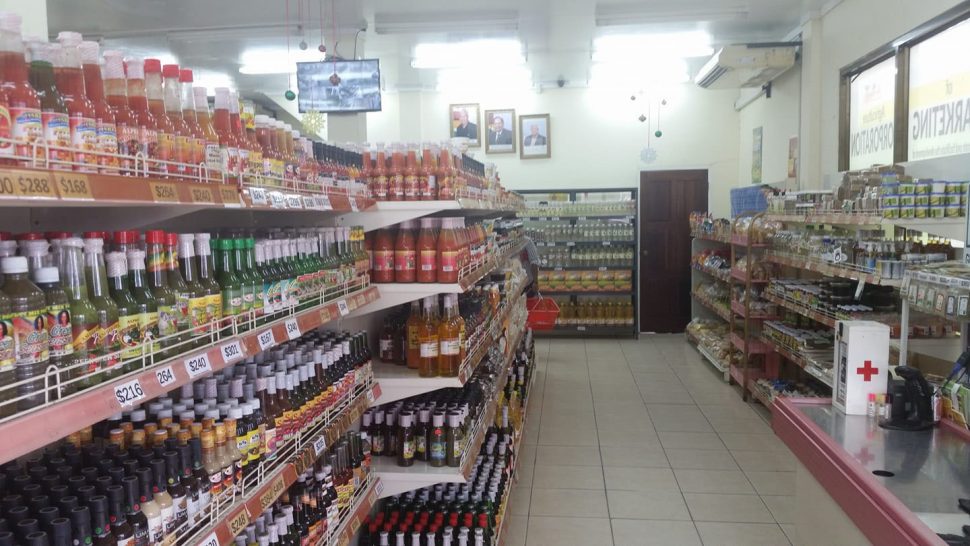In more ways than one The Guyana Shop continues to make its own robust contribution to the growth of Guyana’s agro processing industry. What is essentially a modest state run supermarket situated at the corner of Robb and Alexander streets, close to the hustle and bustle of Bourda Market, has taken on the task of being the flag bearer for the country’s ‘buy local’ clarion call. In circumstances where the country’s major supermarkets are still mostly inching towards embracing the aggressive promotion of local agro products, the Guyana Shop has made that the very purpose of its existence.
In a sense, its real success is reflected in the role it has played in creating a still modest but committed cadre of ‘buy local’ adherents, its range of products ranging from packaged tamarind balls, some of which appear in need of still more product refinement to sauces, seasonings jams and jellies, condiments and a rapidly increasing range of wines and beverages.
The Guyana Shop is no, elaborate, multi-aisled Shopping Plaza. But then that is not what it was fashioned to be. It is much more of an entrepreneurial cradle, a nursery that affords aspiring agro processors their first halting steps into the world of commerce.
The fact that these days The Guyana Shop affords shelf space and attendant market exposure to ninety-five local agro processors is a tribute to its contribution to the small business sector and equally importantly, to employment. Currently, the Shop stocks 1,476 different products, which, among other things, provides an impressive insight into the range and versatility of Guyana’s fruits and vegetables. Between 2017 and this year The Guyana Shop admitted around nineteen new products to its incubator. Each new entrant becomes driven by the quality standard which the Shop has set. It is just the kind of pressure that drives manufacturers to continually aim higher.
The Stabroek Business’ inquiry with the Guyana Marketing Corporation (GMC) revealed that, over time, the Guyana Shop has reached into nine of the country’s ten administrative regions to secure products for display and while, perhaps understandably, the largest volume of products is still supplied by Region Four, some interior communities including Hosororo Hill and Three Brothers Village in Region One, Aranaputa Valley and North Rupununi in Region Nine, North Pakaraima in Region Eight and Amelia’s Ward, Region Ten are more than holding their own in what has become a highly competitive race by agro processors to bring their products to countrywide public attention.
Mindful of the importance of the safety and health considerations associated with food products, The Guyana Shop has set stringent standards for affording shelf space to products. Agro produce seeking shelf space must be manufactured on premises licensed by the Government Analyst- Food & Drugs Department (GA-FDD) whilst packaging and labeling standards also apply. Agro- processors must also produce their Business Registration Certificates, personal identification, TIN Certificates and product price lists in order to be considered for shelf space.
Beyond its Robb and Alexander streets outlet The Guyana Shop has been instrumental in securing shelf space for agro products at privately run businesses outside of the capital. Those additional outlets include Jaigobin & Son Supermarket, Anna Regina; the Safeway Supermarket at Supenaam; Ram’s Supermarket at Vreed en Hoop; R.Prasad’s Service Station at Mon Repos; Rambrich Gas Station at No. 41 Village, Bengal, Corentyne; Spready’s Supermarket at Port Mourant; the Canawaima Ferry Stelling at Moleson Creek; B’s Mart Supermarket in New Amsterdam; Williams Brother Supermarket at Bartica and the Savannah Inn Supermarket at Lethem.
Their in-store product displays apart, The Guyana Shop continues to be active at public events including fairs and market days, often making its employees available to provide various forms of support to vendors. That apart, products displayed at the Guyana Shop are positioned to catch the eye of visitors from abroad keen to acquire a sampling of the range of products for their own kitchens in North America and Europe.
If in the final analysis the Guyana Shop can hardly be compared with an elaborate Shopping Plaza its real impact should be measured through the contribution that it has made to affording hundreds of enterprising Guyanese to move their products from the stage of trial and error to securing a place on the local and in many instances, the international market. That, for a modest agro processors’ incubator is not a small feat.





